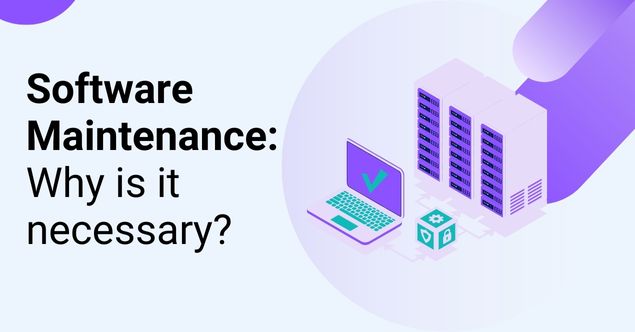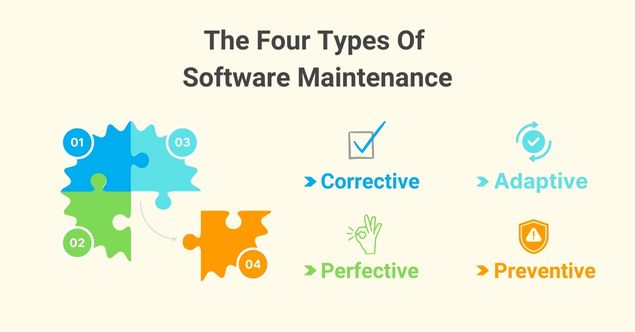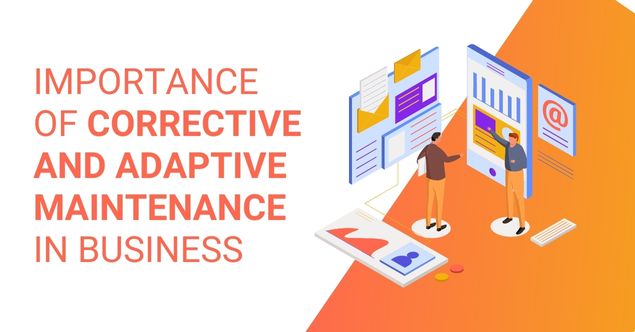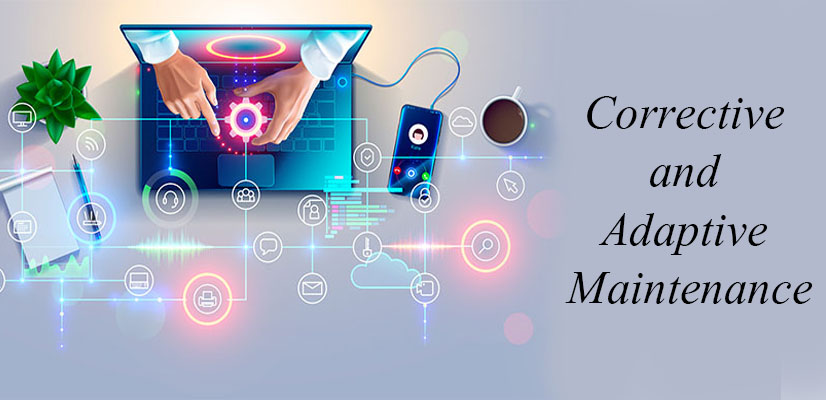Software maintenance is an important aspect of any software development project. It ensures that the software continues to run smoothly and efficiently. It also helps you identify problems before they become major issues. Before we know the importance of Corrective and Adaptive Software Maintenance in Business, let's first understand what is software maintenance.
What is software maintenance?
Software maintenance is the process of keeping software running smoothly by fixing bugs, updating features, and adding new functionality. It’s one of the most important parts of any IT department, but it’s often overlooked because it doesn’t seem like something that needs to happen frequently. In reality, though, it’s a critical part of keeping systems running smoothly.
Software Maintenance: Why is it necessary?

Software maintenance is important because without it, your business would grind to a halt. It’s essential that you keep your software running smoothly so that you don’t lose customers due to downtime.
The cost of maintaining software systems can be high, especially if they are large and complex. In addition, many organizations don’t have the expertise needed to keep their systems running smoothly. This means that they may not be able to respond quickly to changes in business requirements or new technologies.
Also, the cost of maintaining software systems is one of the biggest challenges facing businesses today. In fact, according to Gartner, the average cost per hour spent on software maintenance is $2,000. That’s why many companies are turning to cloud computing solutions to reduce costs and increase efficiency.
"Software maintenance costs can be anywhere from one-third to two-thirds of an entire software development cycle or more than half of the SDLC processes."
Source: (cpl.thalesgroup.com)
The Four Types Of Software Maintenance & How They Help Your Organisation

1. Corrective Software Maintenance
Corrective software maintenance is the process of identifying problems in existing code and fixing them before they become serious issues. It usually involves a combination of manual inspection and automated testing. This type of maintenance is usually done by developers who are familiar with the code base and understand its inner workings.
2. Adaptive Software Maintenance
With adaptive software maintenance, you can reduce the frequency of code changes by using automated tests to identify problems before they become critical issues. This approach allows you to avoid spending time fixing bugs after they have already been discovered.
3. Perfective Software Maintenance
In software development, perfective maintenance means fixing bugs after they occur. It’s not just a matter of “fixing” them; it’s about making sure they don’t happen again. This type of maintenance requires constant vigilance, which is why it’s often referred to as “perfective” because it’s never done perfectly.
4. Preventive Software Maintenance
Preventive software maintenance is all about preventing problems before they occur. It involves identifying potential issues, testing them out, and fixing them before they become major headaches. This type of maintenance is often done by developers who test new code before it goes live.
The Software Maintenance Process
The software maintenance process consists of three phases: planning, execution, and evaluation. Planning involves determining what needs to be done, when it should be done, and by whom. Execution includes actually doing the work. Evaluation is the process of analyzing the results of the work.
Software maintenance is one of the most important aspects of software development. It involves making sure that your code is working properly and that no bugs exist.
This process requires constant monitoring and testing of the software. If any problems arise during the course of the project, then the team must fix them as quickly as possible.
Importance of Corrective and Adaptive Maintenance in Business

Corrective maintenance is the process of identifying problems with equipment and fixing them as soon as possible. It is also known as preventive maintenance. This type of maintenance is important because it prevents breakdowns and reduces downtime.
However, adaptive maintenance is different. It is the process of identifying new problems and correcting them before they become major issues. This type of maintenance allows businesses to avoid costly repairs.
Corrective software maintenance
Corrective software maintenance is the task that detects faults, fixes bugs, and makes changes in the system. It often comes in the form of semi-regular updates. It makes the user experience flawless and more reliable.
Types of Corrective Maintenance
There are mainly two types of corrective maintenance :
1) Unscheduled Corrective Maintenance: This type of maintenance is needed but not required to be performed urgently.
2) Scheduled Corrective Maintenance (or Emergency Maintenance): When a critical failure occurs, this maintenance must be performed without any delay.
As a business manager, you have to check whether all your workforce networks are free from defects for easily communicating with your team, conducting efficient meetings on a fixed time. Efficiency experts monitoring employee routines is a common example of corrective maintenance. Trimming the redundant tasks and assembling them into a single one saves your company’s valuable time and money.
Corrective Maintenance helps in promoting the top-performing employees and strengthen your company’s backbone in the time of crisis. To avert future failure, a history of the corrective maintenance activities is stored in Computerized Maintenance Management (CMMS) software to speed up the repairing process.
"However, one study found that 80% of maintenance efforts are spent on non-corrective activities."
Source: (en.wikipedia.org)
Advantages of Corrective maintenance
Disadvantages of Corrective maintenance
Corrective Maintenance Workflow
Corrective maintenance workflows are used to identify and correct problems with your systems. They help you find out what went wrong so you can fix it. This process requires a lot of manual effort. It also takes time and resources away from more important tasks. A workflow automation tool can automate most of the steps involved in corrective maintenance workflows.
How Are Corrective Maintenance Needs Identified?
In corrective maintenance needs are identified by comparing the actual condition of the asset with its expected condition. This comparison is done using a variety of methods including visual inspection, physical testing, laboratory analysis, and expert opinion. Once the corrective maintenance needs are identified, they are prioritized based on the level of risk associated with each need.
The first step in identifying corrective maintenance needs is to determine whether the problem exists. This is done by performing a visual inspection of the equipment. If the equipment appears to be operating normally, then the issue may be related to the operator.
If the equipment does not appear to be working properly, then the next step is to identify the cause of the malfunction. To do so, the technician must examine the equipment and its components. He or she should also check the environment surrounding the equipment.
Finally, the technician should review any documentation that might help explain the problem. Once all of these steps have been completed, the technician can make a determination as to what type of corrective maintenance needs exist.
Adaptive software maintenance
Adaptive software maintenance is the implementation of changes in a software product to keep a product usable in a changing atmosphere. Here atmosphere refers to the work patterns, business rules, government policies that have a significant effect on the software system.
Systems don’t work in isolation. They interact with different databases, GUI, operating systems, network protocols, external software packages, that often changes over a short period. The process of analyzing the effects of such changes on the software system and adjusting the system to make balance with them is called “Adaptive Maintenance”.
Adaptive maintenance has two groups :
1) Changes that occur by modification of government policies or changes in legal forms.
2) Changes that occur by changing technologies, for example, continuous development in software packages, operating systems, etc.
Corrective maintenance works as a profitable strategy when it comes to management level. However, Adaptive maintenance acts as a “war-time” strategy for businesses. Businesses face conflict when their competitors attack the company’s main product lines. In this type of situation, you need to conduct meetings to project plans for the company.
At this time, adaptive strategies emphasize on more profitable segments and divesting from the losing segments. Adaptive maintenance includes improving existing business accounts or introducing new ones. Pay attention to government regulations, commodity costs, and discretionary spending to make sure you stand ahead of the competition.
Advantages of Adaptive maintenance
Disadvantages of Adaptive maintenance
Adaptive software maintenance is the implementation of changes in a software product to keep a product usable in a changing atmosphere. Here atmosphere refers to the work patterns, business rules, government policies that have a significant effect on the software system. Systems don’t work in isolation. They interact with different databases, GUI, operating systems, network protocols, external software packages, that often changes over a short period.
FAQ's on Corrective and Adaptive Software Maintenance in business:
If you want to reduce corrective maintenance, you should consider using a product that contains an antimicrobial agent. These products are designed to kill microorganisms on contact, so they will help prevent the growth of mold or mildew.
Software maintenance costs are estimated based on the software development team size, the number of releases per year, and the average cost of each release.
Preventive maintenance plans are designed to keep equipment running smoothly for longer periods of time. They can be used to prevent breakdowns or to reduce downtime caused by equipment failure.
Corrective maintenance improves reliability by preventing breakdowns before they occur.
Software developers are responsible for maintaining their own code. They should ensure that they write good quality code, test it thoroughly, and keep up with new developments in the industry. And If you're working on an open source project, you'll also need to make sure that the community around the project maintains its code.
There are two main types of maintenance in software development: Preventive and corrective. Preventive maintenance involves making sure that you don't break anything while you're working on new features or fixing bugs. Corrective maintenance involves fixing things when they go wrong.
There are many factors that affect how well an app performs over time. These include the number of users, the type of device they use, and the amount of data they consume. In addition, there are also issues related to the way the app was developed or implemented. For example, if you develop an app for iOS devices, you need to make sure that it works on both iPhone and iPad models.
Summary
The adaptive and corrective software maintenance strategy helps the business to change with new hardware systems and keep the software product usable in a changing atmosphere. This type of maintenance is important for companies because it can help prevent break downs and reduce downtime. Estimating software maintenance costs can be difficult, but it is typically based on the development




